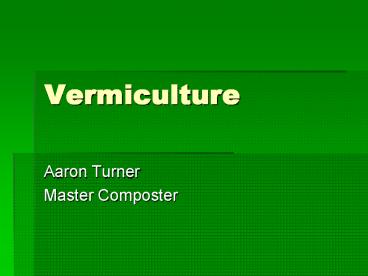Vermiculture - PowerPoint PPT Presentation
1 / 21
Title:
Vermiculture
Description:
Helps meet the goal of decreasing organic waste from entering the ... Post on Craigslist.org garden section. The goal is to keep material out of the landfill! ... – PowerPoint PPT presentation
Number of Views:6678
Avg rating:3.0/5.0
Title: Vermiculture
1
Vermiculture
- Aaron Turner
- Master Composter
2
Why Vermicomposting for urban situations?
- EASY!!
- Helps meet the goal of decreasing organic waste
from entering the waste stream - Excellent for small spaces and for those without
a yard - Increase knowledge of living cycles
- Decomposition
- Reuse of materials
- Create a useable product that is beneficial to
plant life
3
Why its really important to be knowledgeable of
vermicomposting
- As a Master Composter, our goal is to entice
individuals to do their part of diverting organic
waste from the landfill. The number one reason
people say they cant compost is because they
dont have space. You then show them your travel
bin and how easy it is to use voila!
4
Definitions
- Vermiculture
- The use of worms to break down organic material
in either an enclosed or open composting
situation. - Vermicompost / Worm Castings
- Compost made primarily by the activity of a
concentrated population of worms. - Bedding
- Material which is used to cover the mass of worms
and the organic material that they are breaking
down. - Organic material
- Material broken down by worms.
5
Worms, Worms, worms
- Types of worm
- Large worms
- Earthworms / Nightcrawlers Lumbricus terrestris
- Medium worms
- Red Worm Lumbriscus rubellus
- What is usually used in closed bins
- Small Worms
- Compost worm Eisenia fetida
- Author believes that these are the most common in
closed bins
6
(No Transcript)
7
Reproduction
- Hermaphroditic Have both male and female
reproductive organs. - Takes two to tango
- Exchange liquids produced in clitellums the
ring-like structure - After fertilization, the secretions form into a
tube - The tube hardens and the worm wriggles backward
until the tube is released as a lemon shaped
cocoon. - They change color during their development, first
white, becoming yellow, later brown. When new
worms are ready to emerge, the cocoons are
turning red. It takes at least three weeks for
the worms to develop in the cocoon. Temperature
and other conditions are factors in the
development of the hatchlings. - Cocoon may contain up to twenty eggs, but only
two or three will hatch into small worms.
8
Worms Habitat
- Earthworms move nutrients through the soil
profile down to 6 feet deep and create aerate
soil. - Red Worms live in the top few inches of soil
where decomposing organic matter is found like
leaf litter or kitchen/manure compost piles. - Compost worms are found mostly where compost
piles are present, for instance farms or stables.
9
Worm Bin Habitat
- Creating a beneficial habitat for red worms to
thrive and break down organic matter into a
usable form for plant life. - Temperature
- Light
- Airflow
- FOOD!
10
Design of vermiculture bins
- Dozens of different types of worm bins
- Stacked Containers
- Plastic containers modified for drainage and
airflow. - Multi-level worm bins
- Wriggly Ranch
- All have aeration and drainage
11
(No Transcript)
12
(No Transcript)
13
What to feed worms
- Decaying organic matter
- Kitchen scraps
- Be cautious of seeds going into your bin
- Egg Shells rinsed and crushed
- Bread / Pasta
- Coffee grounds
- Tea bags
- Shredded paper
14
What you shouldnt feed worms
- Pet waste
- Cabbage family scraps
- Garlic, onion, hot pepper scraps
- Citrus
- Salty foods
- Meat/Dairy products
- Remember experiment and observe what you put in
and how worms react. You be the judge.
15
Where can I keep my bin?
- Kitchen
- Outside - out of the sun and out of the cold
- Patio
- Under desk at work
- In car when traveling (as long as the temperature
is kept in mind)
16
Maintain
- Add Organic matter
- Keep bedding on top of scraps to keep fruit and
common flies out of bin - especially important if maintaining bin indoors.
- Maintain even moisture levels
- Not too wet or dry just right
- Feed smaller scraps
- Move your deposits around the bin
17
When to Harvest?
- Depends on your needs and the size of your bin
- Smaller bins need to be harvested more frequently
than large bins - When you have lots of worms and want to create
another bin for a friend!
18
Harvesting Methods
- Volcano Method
- Drop through screen
- Tarp Method
- Slurry Method
19
Troubleshooting Bin issues
- Worms are dying or trying to escape
- Too wet or too dryor too hot. Balance.
- Bedding is used up
- Add more bedding
- Bin Bin stinks!
- Not enough air
- Too much food slow down adding organic matter
- Too wet -
- Drill more ventilation holes
- Add more bedding
- Fruit Flies - Increase amount of bedding
20
Uses of Vermicompost
- Add to potting soil 50
- Use as a disease control spray on plants
- Use in gardens once sifted
- Add to shrubs around apartments, buildings.
- Share with friends
- Post on Craigslist.org garden section
- The goal is to keep material out of the landfill!!
21
Questions or comments?



















![Somaiya Vidyavihar University - [SOMA], Mumbai PowerPoint PPT Presentation](https://s3.amazonaws.com/images.powershow.com/9672743.th0.jpg?_=20211016103)











